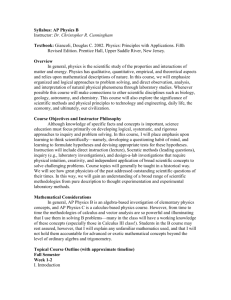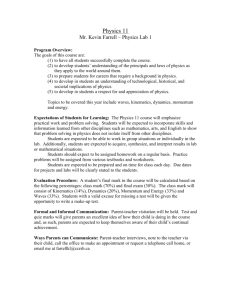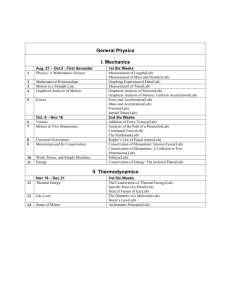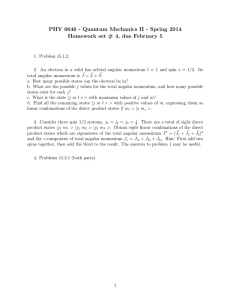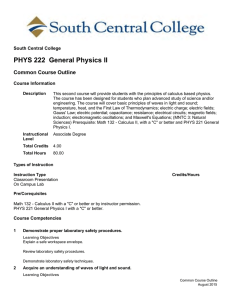PreAP Physics
advertisement
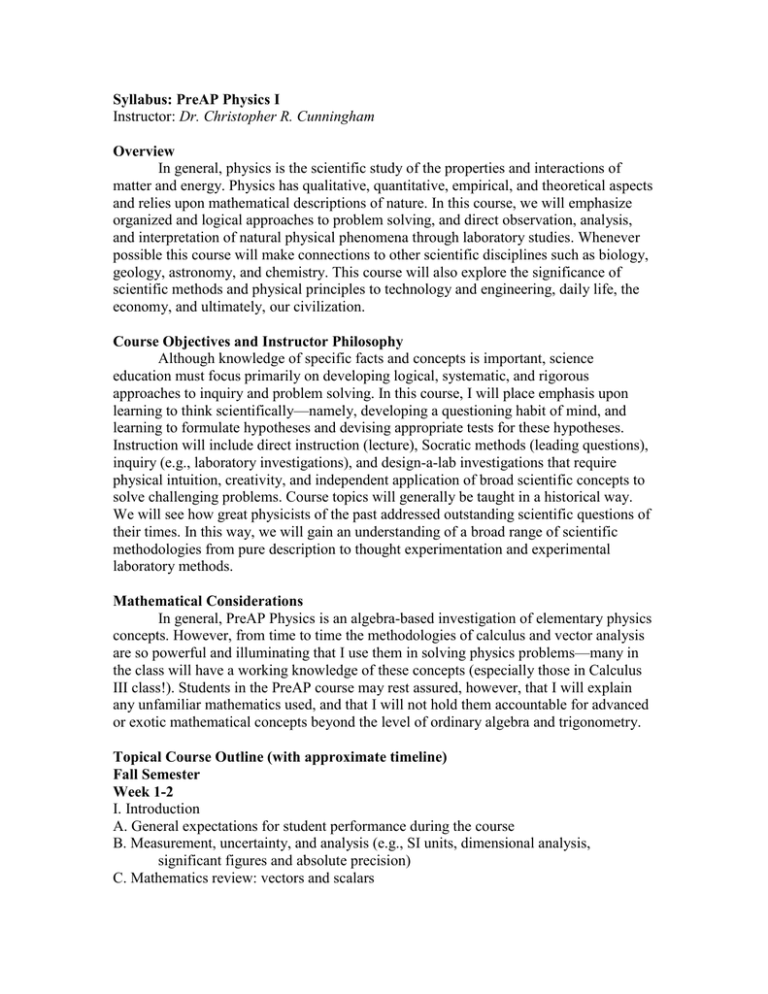
Syllabus: PreAP Physics I Instructor: Dr. Christopher R. Cunningham Overview In general, physics is the scientific study of the properties and interactions of matter and energy. Physics has qualitative, quantitative, empirical, and theoretical aspects and relies upon mathematical descriptions of nature. In this course, we will emphasize organized and logical approaches to problem solving, and direct observation, analysis, and interpretation of natural physical phenomena through laboratory studies. Whenever possible this course will make connections to other scientific disciplines such as biology, geology, astronomy, and chemistry. This course will also explore the significance of scientific methods and physical principles to technology and engineering, daily life, the economy, and ultimately, our civilization. Course Objectives and Instructor Philosophy Although knowledge of specific facts and concepts is important, science education must focus primarily on developing logical, systematic, and rigorous approaches to inquiry and problem solving. In this course, I will place emphasis upon learning to think scientifically—namely, developing a questioning habit of mind, and learning to formulate hypotheses and devising appropriate tests for these hypotheses. Instruction will include direct instruction (lecture), Socratic methods (leading questions), inquiry (e.g., laboratory investigations), and design-a-lab investigations that require physical intuition, creativity, and independent application of broad scientific concepts to solve challenging problems. Course topics will generally be taught in a historical way. We will see how great physicists of the past addressed outstanding scientific questions of their times. In this way, we will gain an understanding of a broad range of scientific methodologies from pure description to thought experimentation and experimental laboratory methods. Mathematical Considerations In general, PreAP Physics is an algebra-based investigation of elementary physics concepts. However, from time to time the methodologies of calculus and vector analysis are so powerful and illuminating that I use them in solving physics problems—many in the class will have a working knowledge of these concepts (especially those in Calculus III class!). Students in the PreAP course may rest assured, however, that I will explain any unfamiliar mathematics used, and that I will not hold them accountable for advanced or exotic mathematical concepts beyond the level of ordinary algebra and trigonometry. Topical Course Outline (with approximate timeline) Fall Semester Week 1-2 I. Introduction A. General expectations for student performance during the course B. Measurement, uncertainty, and analysis (e.g., SI units, dimensional analysis, significant figures and absolute precision) C. Mathematics review: vectors and scalars 1. Resolution of vector components (with trigonometry review); vector addition and subtraction 2. Vector multiplication a. Scalar multiples of vector quantities b. Dot products c. Cross products II. Scientific methods A. What is science? B. Qualitative, quantitative, and empirical methods C. Falsifiability: hypotheses, theories, and scientific laws Week 3-5 III. Newtonian (Classical) mechanics A. Kinematics 1. Motion in one dimension a. Distance and displacement b. Speed and velocity c. Acceleration d. Position function and equations of motion e. Relative motion 2. Motion in two dimensions, including projectiles B. Dynamics and Newton’s laws of motion 1. Static equilibrium and the law of inertia (1st law) 2. Dynamics of a single particle: F =ma (2nd law) 3. Action-reaction principle/systems of two or more objects (3rd law) 4. Types of forces a. Fundamental forces (field forces) b. Mechanical forces (e.g., Hooke’s law) c. Conservative versus non-conservative (e.g., frictional) forces Week 6-7 C. Work, energy, power 1. Work-energy theorem 2. Potential energy 3. Kinetic energy 4. Mechanical energy 5. Conservation of energy 6. Power 7. Review of simple machines Week 8 D. Systems of particles and linear momentum 1. Center of mass 2. Impulse (and impulse-momentum theorem) 3. Elastic and inelastic collisions 4. Conservation of linear momentum Week 9-12 E. Circular motion and rotation 1. Uniform circular motion: centripetal acceleration and force (“force that maintains circulation”) 2. Rotational kinematics a. Angular displacement b. Angular speed and velocity c. Angular acceleration d. Position function and equations of rotational motion 3. Rotational dynamics a. Moment of inertia b. Torque and rotational equilibrium c. Newton’s laws for rotation d. Angular momentum and its conservation F. Gravitation 1. Kepler’s laws of planetary motion and the conic sections 2. Newton’s law of universal gravitation G. Oscillations and simple harmonic motion (dynamics and energy relationships) 1. Mass on a spring 2. Pendulum and other oscillators Week 13 IV. Fluid mechanics (hydrostatics and dynamics) A. Hydrostatic pressure, equilibrium, Pascal’s principle, and isostasy B. Buoyancy and Archimedes’ principle C. Fluid flow continuity equation D. Bernoulli’s equation Week 14-17 V. Thermal Physics A. Temperature and heat 1. Mechanical equivalent of heat 2. Heat transfer methods and thermal expansion B. Kinetic theory and thermodynamics 1. Ideal gases a. Kinetic model b. rms speed of gas molecules c. Avogadro’s number and Boltzmann’s constant d. Ideal gas law 2. Thermodynamic processes and the four laws of thermodynamics a. Thermal equilibrium (0th law) b. Isovolumetric, isothermal, isobaric, and adiabatic processes c. First law (with pressure-volume phase diagrams) d. Entropy principle and the Second law the (with heat engines and the Carnot cycle) Week 18: Semester review/finals Spring Semester Week 1-4 VI. Waves and Optics A. Wave motion 1. Traveling waves a. Anatomy of waves: amplitude, wavelength, etc. b. Doppler effect 2. Wave propagation a. Wave types: longitudinal (e.g., sound) and transverse (e.g., light) b. Intensity c. Polarization 3. Standing waves a. Harmonics b. Resonance 4. Superposition principle B. Physical optics 1. Interference: constructive and destructive a. Single slit b. Double slit c. Interferometers and the Michelson-Morley experiment d. Thin films 2. Diffraction 3. Dispersion 4. Electromagnetic spectrum C. Geometric optics and ray diagrams 1. Reflection a. Plane mirror b. Spherical and other mirrors c. Law of reflection d. Image types, magnification 2. Refraction a. Snell’s law b. Lenses 1. Concave 2. Convex 3. Thin lens/mirror equation with sign conventions Week 5-7 VII. Electricity and magnetism A. Electrostatics 1. Electric charge and Coulomb’s law 2. Conductors and insulators 3. Electric fields, potentials, and potential energy (around point charges and other objects) 4. Gauss’s law B. Capacitors 1. Capacitance 2. Parallel plate and other geometries (cylindrical, etc.) 3. Dielectrics Week 8-9 C. Electric circuits 1. Electric battery 2. Direct current, resistance (and resistivity), and voltage: Ohm’s law and electric power 3. Direct series circuits (batteries and resistors only) 4. Direct parallel circuits (batteries and resistors only) 5. Direct combination circuits (batteries and resistors only) 6. RC circuits a. Steady state b. Charging and discharging (transients) D. Magnetic fields 1. Magnetic polarity and field geometry 2. Gauss’s law for magnetic fields Week 10-12 E. Electromagnetism 1. Magnetic fields around wires with current: Ampere’s law (and the BiotSavart law) 2. Lorentz force (forces on charges moving through space and through wires) 3. Electromagnetic induction (Faraday’s and Lenz’s laws): electric generators and motors and ac currents 4. Coils and inductance Week 13 5. Synthesis: Maxwell’s equations a) Gauss’s law for electric fields b) Gauss’s law for magnetic fields c) Faraday’s law of electromagnetic induction d) Ampere-Maxwell law (with displacement currents) e) Maxwell’s concept of the electromagnetic wave Week 14-16 VIII. Modern Physics A. Quantum physics: atoms, nuclei, particles; photons 1. Cavity radiation: Planck’s quantum hypothesis 2. Photoelectric effect and photons 3. Compton scattering 4. Atomic structure a. Greek theories b. Dalton c. Thomson d. Rutherford e. Bohr: quantized energy and angular momentum 5. de Broglie: matter waves and particle-wave duality 6. Heisenberg uncertainty principle 7. Nuclear physics a. Nuclear forces (strong and weak) b. Nuclear reactions: modes of radioactive decay; fission and fusion Week 17 B. Review of Einstein’s special theory of relativity 1. Einstein’s postulates 2. Time dilation 3. Fitzgerald (length) contraction 5. Mass-increase 6. Mass-energy equivalence Week 18: semester review/finals Laboratories The laboratory component of this course contains three “levels.” Instructor demonstrations include the electrostatics of materials (fur, plastics, etc.), Van de Graaff generator, discharge tubes, standing sound waves in a pipe, longitudinal and transverse wave in a spring, angular momentum conservation on a turntable, etc. Hands-on studentconducted labs include more or less classic “cook book” labs with procedures and expectations clearly indicated and a strong instructor presence and design-a-labs, which require creativity and physical intuition to solve difficult problems. Design-a-labs require students to design procedures to measure physical quantities, conduct experiments using their own procedures, compare their experimental values with accepted ones, identify sources of error, and suggest modifications to their experimental designs in order to improve results. During all laboratory work students are strongly encouraged to work together, discuss, and debate hypotheses, approaches to problem solving, and theory. Laboratory write-ups will normally include an identification of the problem; formulation of a hypothesis; procedures, data, theory and calculations, conclusion, and sources of error. Students will often be encouraged to share their ideas/results with the class. Students must keep a lab notebook to document their work. Evaluation Philosophy and Methods In general, there are two kinds of grades in this class, “daily” (30%) and “major” (70%). All problem sets, quizzes, and labs have equal numerical weight unless I state otherwise. These are “daily” grades. Examinations (tests) are considered “major” grades. I recommend that students not fixate on averages, but rather concentrate on growth and learning the physics. Effort, growth, and dedication may be used in the evaluation process. If you are actively and passionately engaged in the course, grades may not be a strict numbers game.
